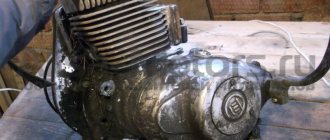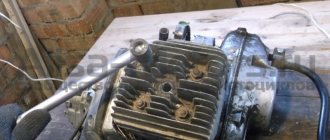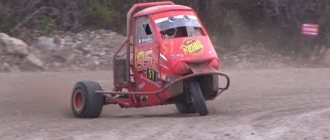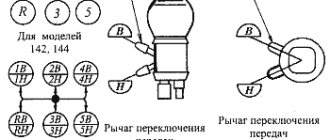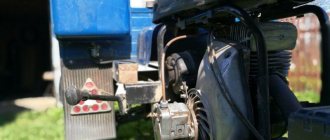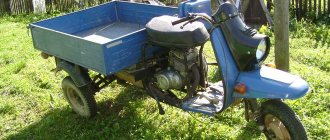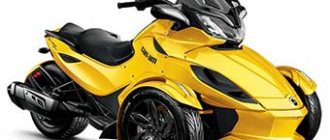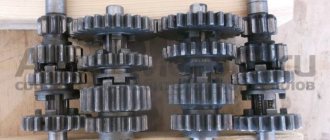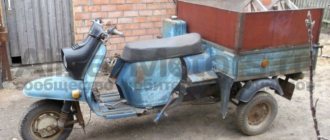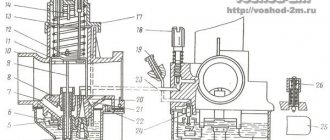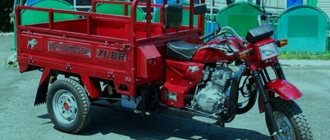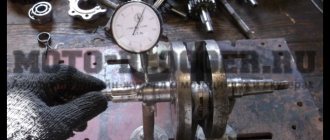Photo report: Engine disassembly
Almost just before leaving for permanent residence on another collective farm, an old acquaintance, whom I had not seen for 15 years, turned to me and asked me to overhaul the engine of his Ant.
To be honest, I didn’t have much of a desire to get involved with this Soviet chatterbox, to say the least... But after thinking about it and playing out the situation in my head that I would have to sit in a new place for some time without my favorite job, I agreed and immediately began the repairs. I will not go into the essence of the disassembly in particular within the framework of this article - I will only outline the main points and, based on my experience, I will try to describe the most common malfunctions and errors during repairs.
The engine had the following symptoms before being repaired:
- Bad start
- Oil leak
- Weak traction
- Increased noise during operation
- The winding lever did not return to its place
- Depressurization of the crank chamber, as well as wear of the seals
- Poor quality assembly
- The piston died
- Bearing wear
- Kickstarter return spring broke
Everything else, including the gearbox and clutch, did not cause any complaints during operation. However, first things first.
Before a major overhaul, I don’t wash the engines - I just drain the oil, pull it off the frame and get to work.
Engine assembly
Unlike a dynastarter, repairing an Ant scooter engine with your own hands is difficult to do according to the operating book. Therefore, it is worth seeking the advice of experienced motorcycle owners. Most often, the engine has to be disassembled when there are problems with the clutch mechanisms, the operation of the gearbox, as well as wear on the crankshaft, bearings or oil seals. The most important rule is not to be afraid to disassemble the engine yourself. Using these instructions, disassembling and assembling the engine of the Ant scooter will not be difficult.
So, the procedure for disassembling the engine:
- To begin, prepare your workspace. If you want to achieve proper and trouble-free operation, keep all parts clean and tidy. Remember and complete the disassembly order.[sc:ads3]
- First of all, remove the engine from the frame. To do this, you will need to remove the supporting hood covering the engine. Simply put, you need to unscrew the deflector, the volute and the wires: high-voltage, positive and ground. You can unscrew it in any order.
- Place the moped at any speed, unscrew the nut securing the dynastarter to the crankshaft and, holding the brake, press it out.
- With the scooter running at speed, unscrew the nut located on the drive sprocket.
- Remove the generator stator by unscrewing the 4 screws and remove the casing with the wires coming from it.
Then we move on to removing the clutch cable and kickstarter lever. Now the task is to remove the muffler. To do this you will need a special key. In some cases, the muffler is attached to the cylinder with two ordinary bolts. Drain the oil from the gearbox by unscrewing the drain bolt. Then unscrew the three points securing the engine. Now you need to unscrew the cylinder secured by 4 nuts located on the head. Remove the head and place the cylinder vertically, upward open part. The piston can be left in the crankshaft unless replacement is required. Otherwise, you need to pull out the retaining rings and then knock out the pin. Now remove the bushing on the secondary shaft, where the drive sprocket was previously. Unscrew the “flower” with the right crankshaft oil seal attached. Then disconnect the kickstarter cover, secured with a thrust bolt and 5 -th screws. Next, the clutch is removed. The central adjusting screw can be left untouched, but the 3 pins with hooks located around it must be unscrewed. Pull out all the clutch discs located inside and remove the clutch lever attached to one bolt. The lever must be removed along with the spring. Use a chisel to break off the lock washers of the crankshaft and clutch basket and remove the rods and balls. After this, the entire structure is removed. Now the engine can be separated into halves, you just need to unscrew all the connecting screws. When all the parts are disconnected, you can address the problem area where problems have arisen.
You can see how to assemble an Ant scooter engine in more detail in the visual video at the end of the article. The essence of assembly is in the reverse order, but it is important to tighten the parts with a certain force and synchronize the parts with the marks. Under no circumstances should you assemble an engine without detailed instructions written by the manufacturer.
With frequent breakdowns, owners think about what engine can be installed on the Ant scooter. Instead of a native motor, you can use Chinese analog motors . Since the Ant has many copies in Asian countries, replacing the engine can be a great option to save money in case of irreversible damage. True, you will have to make the fastenings yourself and, in some cases, remake the bridge for the left-hand arrangement of the chain. This is not very difficult, considering that the Tula plant provided for the possibility of rearranging the bridge.
[sc:ads5]
Removing and checking the piston (CPG)
Remove the cylinder head (cylinder head).
The cylinder head gasket held up well, as evidenced by the absence of oil leaks.
In the upper part of the cylinder opposite the exhaust window, we feel the groove with our finger. If it feels a clearly perceptible so-called “wave”, “step”, that is, a drop, then such a cylinder is no longer subject to further use. It needs to be either bored to repair size or bought a new one.
The wear can be easily felt in the place where the piston rings do not reach the end of the cylinder. In the place where the piston rings do not work, the nominal factory size is maintained, but in the place where they work, the metal wears out. That is why a transition is formed at the boundary of these two sections, which is larger the greater the wear of the cylinder.
In my case, as expected, the wear was clearly palpable and the cylinder mirror was covered in nicks and scratches.
A bunch of hay that blocked the flow of cooling air, in my opinion, did not add efficiency to the cooling system... How can you even drive like that?
The piston turned out to be burst and, moreover, according to the good old collective farm tradition, it was treated with sandpaper. As indicated by numerous risks on its surface.
After removing the clutch cover and removing the kickstarter shaft, the reason for the freezing of the winding lever was found - the return spring had burst in half.
The motor chain turned out to be stretched, but not critically.
Removing the clutch
Unbend the lock washer, insert a tin rod or stick under the tooth of the motor transmission sprocket and unscrew the nut on the crankshaft journal (right-hand thread).
Unbend the lock washer, fix the inner clutch drum with a puller, which is a clutch disc with a welded piece of tire, and unscrew the nut (left-hand thread).
We take out the discs and drum.
Remove the basket from the shaft along with the chain and sprocket.
Removing the dyno starter
We remove the cooling casing and then, if the engine is not converted to a magneto, remove the ignition breaker cam. Hold the dyno starter rotor by the fan and unscrew the nut. If you cannot hold the rotor in this way, fix the crankshaft with something and unscrew the nut.
We pull off the rotor with a puller. The rotor can be pulled off either with a standard puller or with a homemade one. Depending on the situation, I use both standard and homemade ones.
Analysis of previous repair errors
We remove the flange on which the stator is mounted and carefully inspect the connector plane for interference by “drop-dead handles”.
No matter how many times I repair Ants, I come across the fact that all sorts of “drop-dead little hands” seal the oil channel through which oil flows to the crankshaft main bearing and oil seal. I'm already tired, honestly - how much can you? Why cover it up?
It doesn’t matter to me, but how do you think the bearing and oil seal should work without lubrication? Admire what happens to the main bearing when it runs dry.
We unscrew the bolts and half the crankcase.
What's the result?
The crankshaft has been taken away - to say that it is worn out is to say nothing... The gearbox bearings, like the main bearings, have gone to the same place - to the crankshaft: in the trash. The gearbox, with the exception of one fork, did not cause any complaints. By the way, the clutch too.
Now the question is: what to do with all this junk? Buy a “plasticine” crankshaft from no one’s making and mold it into the engine. I was initially against this idea. In general, we found a used engine for a ruble and removed the crankshaft from it. Of course I had to tinker with him. Since the thread was clogged, I sharpened it and straightened it with a sharpening tool.
After correcting the threads, I checked the crankshaft for runout. There was no need to worry - the beating of the trunnions did not exceed one hundredth of a millimeter with a tolerance of three hundredths. By and large, it would have been necessary to replace the bushing of the upper head of the connecting rod, but time was running out and the bushing was not very worn. In all other respects, the crankshaft did not disappoint and this purchase can safely be called a success.
We decided to buy everything else: CPG, cylinder head, gaskets, seals, bearings, motor chain, etc. in the store. Although, by and large, the cylinder could have been bored out and that would be enough. But the owner did not want to wait, but in vain.
How not to make a mistake when choosing a gearbox?
When choosing this device, it is worth considering the work it will perform. Both its reliability and performance, as well as its operational period, will depend on this. If you make a mistake when choosing a device, you can “kill” the gearbox ahead of time. It is advisable to entrust the choice to qualified specialists. They will make all the calculations and advise you on the best option for the task at hand.
But there is not always a chance to get advice from an experienced specialist. In this case, you need to take the initiative into your own hands. The first step is to create the kinematics of the drive. It will tell you what type of gearbox is required for the selected system.
To determine the subordinate number, use the formula:
In this formula, ninput means the number of revolutions that the input shaft has, that is, it shows the engine speed in 1 minute. The noutput parameter means the required number of revolutions that the output shaft needs (also revolutions per minute).
Having made the calculations, the resulting transmission value will need to be compared with the values of the standard series for all types of gearbox. It is important not to forget that the resulting calculation is not exact, it is only approximate. When choosing an electric motor whose shaft rotates at a frequency not exceeding 1500 revolutions per minute, you should take into account the technical characteristics of the electric motor or mechanism itself, and then carry out an analysis and carefully select.
Photo report: Disassembling the engine of the Ant scooter
I recently came across a miracle of Soviet technology called an “ant scooter” for repairs. The engine of this “ant” showed no signs of life. Therefore, I didn’t even bother diagnosing it, and immediately began the overhaul, which I started with its complete disassembly. Moreover, its owner asked that everything be done at the highest level, and the highest level of repair involves a complete disassembly of the engine with subsequent troubleshooting of all components and mechanisms (in my understanding, of course).
We’ll have such a wow copy on the menu today, it’s moderately well-kept, which of course makes us happy.
Pros and cons of helical gearbox
This device has the following advantages:
- very high level of efficiency (up to 98%), and it is extremely economical;
- transmitting high power without losing it;
- very high kinematic accuracy (much higher than that of a globoid, i.e. worm);
- despite the high efficiency, the case does not heat up much, and at the same time energy transfers from the sender to the recipient with almost no losses;
- models perform well under shock loads;
- very high reliability, can continuously operate for at least 25 thousand hours;
- the shaft itself can be rotated.
But, despite the advantages, there are also disadvantages:
- in order to increase the gear ratio, the number of steps should be increased, this will lead to a significant increase in size;
- the noise threshold is very high (this device is much noisier than other modifications);
- in some cases, self-braking is required, but this type of gearbox does not provide it, so an additional device must be installed.
Characteristics of the Ant scooter
The scooter is distinguished by high maneuverability and maneuverability, as well as small dimensions. In the garage it will take up as much space as a heavy motorcycle with a sidecar.
The Soviet scooter "Ant", which is still popular, has the following technical characteristics:
- Length – 2.68 m.
- Width – 1.25 m.
- Height – 1.07 m.
- Dry weight – 240 kg.
- Load capacity – 250 kg.
- Speed – about 30 km/h.
- Gasoline engine, two-stroke, 11 hp.
- 4-speed gearbox + reverse.
- Drum brakes with mechanical drive on each wheel.
Among the advantages of a moped it is worth noting:
- Small turning radius – 3.5 m.
- The lightness of the Ant scooter; motorcycles significantly predominate in weight.
- Low cost - only used devices are available on the market.
There are also disadvantages:
- There are a lot of used equipment on the market.
- The engine has high fuel consumption - from 8 liters. per 100 km. But more often this figure is closer to 10 - 11 liters. per 100 km. due to increased wear.
- Frequent breakdowns due to low reliability, especially of the engine.
Ant owners have the most questions about the engine. After all, I want to moderate my appetite for fuel consumption.
What is a gearbox?
The Ant gearbox is a special mechanism that transmits and converts angular velocity into one or more mechanical gears.
- cylinder (excellent reliability and high degree of performance, standardly applicable for transmissions and conversions of enormous power);
- globoid (high gear ratio, not very high efficiency, excessive heat generation);
- wave (has a reduced efficiency when compared with cylinder);
- spiral (very high load capacity, low weight, and size proportional to mass);
- combined (combines many gears, has an optimal cost, good technical components and a relatively small size).
The standard housing of this device is cast. Very often it is cast from high quality cast iron, in rare cases from steel. If it is necessary for the product to be as light as possible, then a material is used that melts quite easily. At the base of the case there are special “ears”, by which the device is attached to the base.
To prevent oil from leaking, a seal (oil seal) is installed at the shaft output, which prevents oil leakage.
To prevent an increase in internal pressure in the gearbox, it has unusual design features. It is they who do not allow the pressure inside the device to increase during heating of the device.
How to disassemble and reassemble the engine of the Ant scooter?
The motor design is simple. But even this does not protect it from breakdowns, which are often associated with age. You shouldn’t just disassemble the engine, but if the following symptoms appear, you should take up the tools:
- Startup problems.
- Oil leak.
- Lack of traction.
- Increased background noise.
- The winding lever does not return to its place.
Possible breakdowns:
- Worn seals.
- Poor quality assembly after previous repair.
- CPG failure.
- Worn bearings.
- The return spring in the kickstarter has broken.
Note! Before overhauling the power plant, it is not necessary to wash it. Just drain the oil and remove it from the frame.
Cylinder block
After unscrewing several bolts, you need to remove the cylinder head. Pay attention to the worn cylinder head gasket. Opposite the outlet window, you should probe the so-called excavation. If a characteristic wave or step is felt, then such a cylinder needs to be changed or bored.
The piston should be examined for wear. Some “Kulibins” manage to refine it with sandpaper.
Clutch
- Removing the clutch cover and kickstarter shaft. Pay attention to the return spring - it often breaks and the kickstarter does not return to its place. Also at this point you can check the timing chain tension.
- Clutch disassembly. To do this, you will need to unscrew the nuts and remove the pressure plate from the basket.
- The lock washer must be bent and a stick must be inserted under the tooth of the main gear sprocket. Please note that the threads on the crankshaft journal nut are right-handed. The nut needs to be unscrewed.
- There will be another lock washer that needs to be straightened. We take a puller and fix the clutch drum. The clutch nut has a left-hand thread.
- The disc and drum are removed, as well as the clutch basket is removed from the shaft along with the chain and drive sprocket.
Dinostarter
Remove the following elements:
- Cooling casing.
- Ignition chopper cam, but provided that the power plant was not converted to a magneto. In this case, it is necessary to fix the dyno starter rotor. This can be done using the cooling fan or by fixing the crankshaft with improvised means.
- The rotor is dismantled using a puller - standard or homemade.
As a result, the rotor was removed.
Music on the road: how to connect speakers to an amplifier in a car, and which ones are better to choose?
How to fill out the European Protocol in case of an accident, how long is the document valid? Find further information.
How to disassemble?
The gearbox itself is removed from the Ant in a certain sequence. It needs to be disassembled if its operating functions are no longer satisfactory during operation. Sometimes it happens that when it breaks, it is sent to a landfill. But this is fundamentally wrong. This device can almost always be repaired, and it will continue to function and serve for quite a long period. Also, the “Ant” scooter is currently a rarity, and spare parts for it are extremely difficult to find. Therefore, there is no need to “throw away” them in vain.
- The first step is to remove the gearbox from the Ant without damaging it. Then clean the body from contamination and remove all excess.
- Next, you need to unscrew the bolts that tighten the body of the product, and warm up the entire device with a hair dryer. After this, you need to knock on the body with a wooden hammer. This is done until it is divided into 2 parts.
- The next step is to remove all the gears. To do this, you will need to bend the special plates and unscrew all the bolts that hold the body halves together. Then these body bowls are separated, and the corkscrew pin itself is removed. Next the wheel axle is removed. Then the retaining ring and the axle shaft are removed from the housing half.
The device itself is dismantled and mounted on a scooter quite simply, there are almost no problems.
Disassembling the gearbox will also not bring unnecessary trouble. But assembly will also require increased attention; you need to carefully assemble everything, not miss anything or confuse anything. Gears are made of high strength steel (alloy steel), so they very rarely become unusable or deformed. The main problem in most cases lies in the bearings. Therefore, regular and careful attention to these parts is required, in particular to elements such as oil seals.
Spare parts price
Despite the fact that the production of the device stopped long ago, you can still find new spare parts for it that are produced by the industry. Some parts are imported, some come assembled. Supplied in sets:
- Clutch discs.
- Gaskets for power plant and gearbox.
- Nuts.
- Pipes.
- Levers.
The necessary parts can be found on the Internet using store catalogs. Prices for spare parts for the Ant scooter are fair. Here are some examples:
- Clutch disc – 400 rub.
- Kickstarter shaft – 1100 rub.
- Front shock absorber – 1600 rub.
- Gearbox seals – 100 RUR.
- Piston – 2500 rub.
- Gearbox – 14,000 rub.
- Wheel hub – 2000 rub.
Judging by the prices, the device is more than cheap to repair. This is an important operational property for people in rural areas.
Tuning the Ant scooter
In terms of tuning the Soviet Ant vehicle, the owners can’t think of anything. After all, these are often tech-savvy people who like to spend time in the garage. Several directions can be distinguished:
- Weight loss. To do this, you will need to remove “extra” equipment. This includes body kit in the form of wings, hood and fairings, as well as all electrical equipment. To transport goods around the village in the summer, all this is unlikely to be needed.
- Increased output from the power plant . To do this, cut off the dynostarter shaft. The operation will add power and dynamism. The recoil during starting is leveled by trimming the crankshaft.
- Installation of other wheels. Front 4.5 - 9, and rear 7 - 10. Cross-country ability and speed will increase.
- Improvement of the piston group . You can buy a piston with three rings and make an additional window in the cylinder to supply the fuel mixture.
- Magneto and increasing the efficiency of the cooling system are additional tuning.
In terms of engine tuning, some owners took radical measures and installed a Lifan engine (Lifan 188f), which has a volume of 400 cubic meters, on the Ant scooter. cm. And its power is 13 hp. A distinctive feature of this assembly is the variator and centrifugal clutch.
A centrifugal clutch is not the best option for trucks, since when driving on rough terrain on a loaded scooter at low speeds, it may slip. And this incapacitates him.
What modifications of the “Ant” scooter are there in the video:
Tell your friends! Share the article with your friends on your favorite social network using the buttons on the panel.
Damage to the transfer case and its causes
ISOFIX car seat mounting system: child safety comes first
During the union, I worked in the Department of Irrigation Systems, and I know well all the nuances of operating Ant. And in our time, craftsmen remade the scooter in order to squeeze all the power out of it, and it worked. Ant was considered to have one shortcoming - poor stability at speed. If a stone or stump got under the front wheel at speed, the scooter would overturn. Many of my friends suffered because of their recklessness. But overall Ant is a great thing.
Guys, do you think there will be enough power for a tourist if you put the 139th engine on the box from the TMZ200? The 139th c pulled normally, although it weighs 20 kg less than the assembled tourist itself
Device Description
The Ant is much lighter than ordinary motorcycles, so everyone dreamed of owning one. The approximate weight was only 240 kg, which is small considering that it could transport loads several times heavier than itself. Actually, it is because of this that he received the name Ant.
Another advantage of the scooter was and is that you can buy it for a small amount of money. So, you can buy an Ant scooter for only 30,000-50,000 rubles.
The Ant engine is single-cylinder. At the same time, it is quite voracious, so it’s hard to call a scooter an economical vehicle. After all, even a new Ant engine consumes about 8 liters of 80-grade gasoline per hundred, and what can we say about used equipment? After all, if the piston or gearbox is slightly worn out, then the costs increase to 10 liters per hundred. In this case, you can replace damaged spare parts, but it is not easy to buy them, since they are rarely found on sale.
Motor scooter engine Ant
You can buy an already assembled Ant engine, but such luxury is a little expensive.
In general, the Ant scooter is a very durable piece of equipment. The front wishbone suspension is especially well executed. It can last for decades. Many scooter users even claim that it is made better than modern versions of telescopic forks.
Nowadays, most fans of the Ant scooter install rear shock absorbers from a scooter instead of front shock absorbers, because the former are currently in short supply.
The rear suspension is independent. The gearbox drives the rear wheel. This is facilitated by a roller chain running through it. At the same time, the gearbox itself is made quite well. It is located in the very center of the rear axle, making it easy to remove if necessary.
Easy to repair
Thanks to its light weight, the owner of this equipment can easily turn over the Ant scooter, which will allow him to easily carry out repair work. To change a tube, tire or even gearbox, it is absolutely not necessary to remove the wheel.
The scooter is large in size, making the equipment excellent for work in rural areas.
The scooter can reach a maximum speed of 50-60 km/h.
